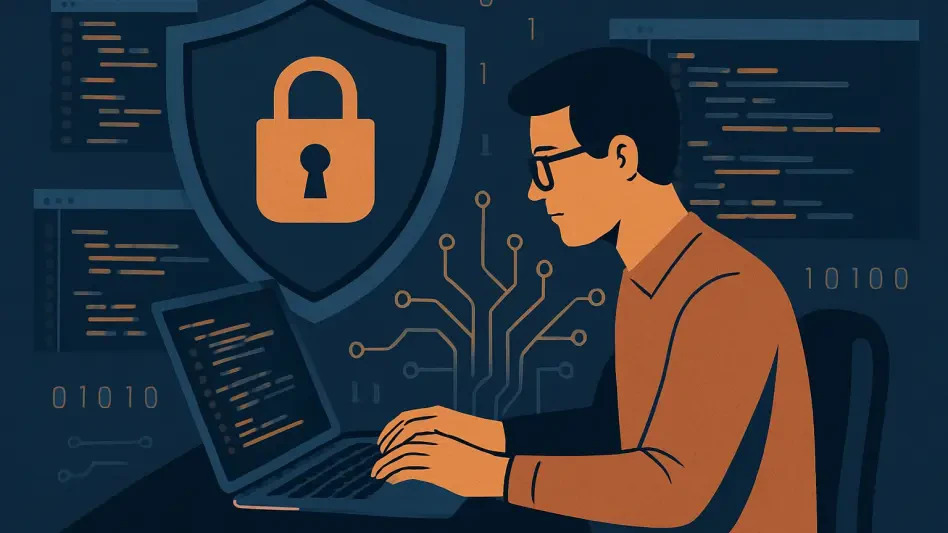In an era where software vulnerabilities lead to billions of dollars in losses annually due to cyberattacks, the quest for secure coding solutions has never been more urgent, especially as data breaches expose sensitive information at an alarming rate. Developers face immense pressure to produce code that is not only functional but also fortified against threats like SQL injection and cross-site scripting. Enter OpenAI’s GPT-5, a groundbreaking large language model promising to revolutionize secure code generation. This review delves into the capabilities of this cutting-edge AI, exploring how it aims to transform software development by minimizing security flaws through intelligent automation.
Key Features of GPT-5 in Secure Coding
GPT-5 stands out in the crowded field of AI-driven coding tools with its advanced reasoning capabilities, designed specifically to enhance security outcomes across multiple programming languages. Unlike earlier models, this iteration focuses on identifying and mitigating vulnerabilities during the code generation process, effectively acting as an internal reviewer before output is finalized. Its ability to handle complex tasks in languages like Java, Python, and JavaScript positions it as a versatile tool for developers tackling diverse projects.
A notable feature is the model’s tailored training data, which reportedly includes scenarios from capture-the-flag hacking challenges. This unique approach equips GPT-5 with a deeper understanding of potential security pitfalls, enabling it to avoid common errors that plague less specialized models. The emphasis on reasoning over mere pattern recognition sets it apart, ensuring that the code it produces aligns with best practices in security.
Additionally, GPT-5 offers variants like GPT-5-mini, which retains much of the core model’s strength in secure decision-making while being optimized for efficiency. This adaptability makes it suitable for a range of applications, from large-scale enterprise systems to smaller, resource-constrained environments. Such flexibility underscores the model’s potential to integrate seamlessly into existing development workflows.
Performance Analysis Based on Recent Benchmarks
According to a comprehensive report by a leading security analysis firm released this year, GPT-5 reasoning models achieved secure coding decisions in 70% to 72% of benchmark tasks. These tasks tested the model’s ability to prevent critical vulnerabilities such as weak encryption and log injection, demonstrating a marked improvement over predecessors that scored significantly lower. This leap in performance highlights the model’s refined approach to tackling security challenges.
In comparison, competing models from other organizations, such as Anthropic’s Claude and xAI’s Grok, lagged behind with secure decision rates ranging from 49% to 55%. This disparity suggests that GPT-5’s focus on reasoning processes provides a distinct edge, particularly in high-stakes scenarios where even a single flaw can lead to catastrophic breaches. The benchmarks reveal a clear leader in the domain of AI-assisted secure coding.
However, not all variants of GPT-5 performed equally. Non-reasoning versions, such as GPT-5-chat, managed only a 52% security pass rate, underscoring the critical role that advanced logic plays in achieving superior outcomes. This gap within the same family of models illustrates that raw computational power alone is insufficient without a robust framework for decision-making.
Real-World Impact and Industry Applications
In practical settings, GPT-5’s capabilities are already showing promise, particularly in industries where security is paramount, such as fintech and healthcare. For instance, developers in financial technology are leveraging the model to automate the creation of secure APIs, ensuring that transactions remain protected against unauthorized access. This application not only speeds up development cycles but also reduces the likelihood of costly errors.
Beyond specific sectors, the model’s ability to generate secure code for web applications offers broad benefits. By minimizing vulnerabilities like cross-site scripting in initial drafts, it allows teams to focus on refining functionality rather than fixing foundational flaws. Such efficiency could redefine timelines in software projects, especially for startups racing to bring products to market.
The ripple effects extend to training and upskilling as well. With GPT-5 integrated into development environments, junior developers gain exposure to high-quality, secure code examples, accelerating their learning curve. This indirect educational impact could help address the industry-wide shortage of skilled professionals equipped to handle modern security challenges.
Challenges and Areas for Improvement
Despite its impressive performance, GPT-5 is not without shortcomings, as evidenced by a 30% rate of insecure decisions in benchmark tests. This significant margin of error indicates that human oversight remains essential, as AI alone cannot fully guarantee safe code in every context. Developers must remain vigilant, manually reviewing outputs to catch potential oversights.
Another hurdle lies in the model’s limited contextual awareness of live applications. While it excels in controlled test environments, real-world systems often involve dynamic variables and unforeseen interactions that the AI struggles to anticipate. This gap necessitates additional safeguards, such as static application security testing, to complement its capabilities.
Moreover, the inconsistency across different language models in the industry points to a broader challenge in standardizing secure code generation. Until training methodologies and priorities align more closely among AI developers, outcomes will vary, leaving room for uncertainty. Addressing these disparities will be crucial for widespread adoption of such technologies.
Looking Ahead: The Future of AI in Secure Coding
As the landscape of AI-driven coding evolves, GPT-5’s trajectory suggests exciting possibilities for further refinement over the coming years, potentially from this year to 2027. Enhancements in reasoning depth and training specificity could push secure decision rates even higher, reducing reliance on manual intervention. Such progress would mark a significant step toward more autonomous development tools.
Industry trends also indicate a growing recognition of the need for layered security strategies. Future iterations of models like GPT-5 might integrate more seamlessly with existing tools like software composition analysis, creating a more holistic defense against vulnerabilities. Collaboration between AI developers and security experts will be key to realizing this vision.
Ultimately, while GPT-5 has set a new benchmark, the journey toward fully secure, AI-generated code remains ongoing. Continued investment in research, coupled with a commitment to balancing automation with human expertise, will shape the next phase of this transformative technology. The focus must remain on building robust frameworks that prioritize safety without sacrificing innovation.
Final Thoughts
Reflecting on this evaluation, GPT-5 emerged as a standout in the realm of secure code generation, with its reasoning capabilities driving unprecedented performance in benchmark assessments. The analysis highlighted its superiority over competitors and underscored the practical benefits it brought to industries reliant on airtight software security. Challenges such as inconsistent decision-making and contextual limitations were evident, yet they did not overshadow the model’s potential.
Moving forward, stakeholders should prioritize integrating this technology with comprehensive security measures, ensuring that AI serves as a powerful ally rather than a sole solution. Developers and organizations are encouraged to explore pilot programs that test GPT-5 in varied environments, gathering data to inform future improvements. Additionally, fostering dialogue between AI innovators and cybersecurity professionals could accelerate the development of more resilient tools, paving the way for a safer digital ecosystem.








